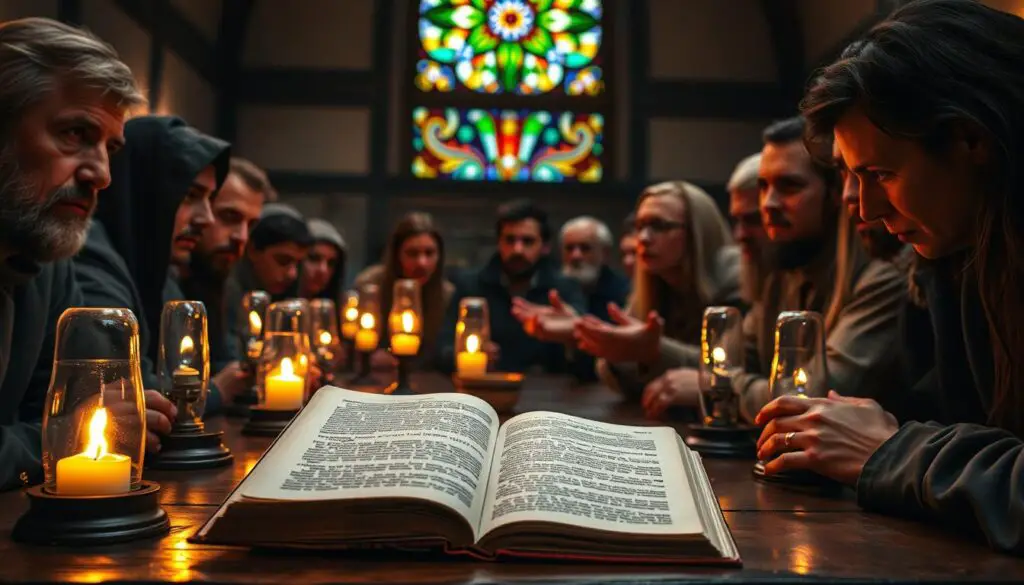For decades, young representatives of The Church of Jesus Christ of Latter-day Saints have walked neighborhoods worldwide. Their approach—engaging strangers through personal visits—remains one of the most recognizable forms of faith-sharing today. This tradition continues to spark curiosity, admiration, and occasional questions.
These volunteers dedicate up to two years to their work, balancing structured schedules with spontaneous conversations. While door-knocking is central, their efforts extend to community service and cultural exchanges. Their goal? To share a message they believe can uplift lives.
This article explores how this practice evolved from 19th-century roots to modern-day strategies. You’ll learn about its role in shaping communities and discover respectful ways to interact with missionaries. Real stories from volunteers and recipients add depth to the discussion.
Whether you’ve met these messengers before or are simply curious, understanding their purpose fosters meaningful dialogue. Let’s explore a tradition that bridges generations and continents—one conversation at a time.
Key Takeaways
- Missionary work combines door-knocking with community service and cultural engagement
- Volunteers typically serve full-time for 18-24 months during young adulthood
- The practice has historical roots but adapts to modern communication trends
- Interactions often focus on shared values rather than immediate conversion
- Missionaries follow strict codes of conduct and personal development guidelines
- Understanding their purpose leads to more constructive conversations
The History Behind Mormon Missionary Work
The tradition of sending volunteers to share religious teachings began with Joseph Smith’s spiritual experiences in the 1820s. His reported First Vision at age 14 became the cornerstone for organized outreach efforts. Early followers faced skepticism but maintained fervor for spreading their message.
Early Beginnings and Joseph Smith’s Influence
Historical records show Smith’s accounts of divine guidance inspired the first missions. By 1830, small groups traveled on foot across New York and Ohio. “The truth will cut its own way,” Smith wrote, emphasizing grassroots sharing over formal debates.
“We differed from other faiths because we claimed modern revelation – that required personal testimony.”
Evolving Practices Over the Years
Mission strategies transformed dramatically:
| Era | Training | Duration | Focus |
|---|---|---|---|
| 1830s | No formal preparation | Weeks | Local communities |
| Present Day | 6-week intensive courses | 24 months | Global outreach + service |
Modern Latter-day Saints missionaries blend tradition with technology. While door approaches remain common, many now use social media. The core principle stays unchanged: sharing beliefs through respectful dialogue.
Understanding this history helps explain why young members still dedicate years to this work. From handwritten letters to video calls, methods adapt – but the mission continues.
Understanding Mormon Door To Door Proselytization
Young volunteers from The Church of Jesus Christ of Latter-day Saints serve as spiritual ambassadors during their missions. Their work blends scheduled activities with spontaneous connections, creating a unique rhythm of service and sharing.

The Heart of Missionary Service
These representatives dedicate 18-24 months to studying scriptures, engaging communities, and offering practical help. Each morning begins with spiritual preparation – reading sacred texts and planning neighborhood visits. Afternoons mix teaching opportunities with service projects like park cleanups or food drives.
Building Connections Through Conversation
Volunteers follow structured routines to balance outreach efforts:
- Morning study sessions strengthen personal faith
- Afternoon visits focus on listening as much as sharing
- Evening reflections help refine communication approaches
One missionary notes: “We’re not just sharing messages – we’re building bridges.” This philosophy explains why many start conversations by discussing shared values rather than doctrine. Community members often recall how these interactions led to unexpected friendships or renewed hope.
The gospel message remains central, but delivery methods evolve. While face-to-face visits stay common, some teams now use social media to arrange discussions. Through all approaches, the goal persists: offering people an opportunity to explore faith through open dialogue.
Engaging With Missionaries: Practical Tips and Respectful Conversations
Meeting volunteers from The Church of Jesus Christ of Latter-day Saints can spark meaningful exchanges when approached thoughtfully. These encounters often work best when both parties prioritize kindness and curiosity. Below are strategies to turn brief visits into opportunities for mutual understanding.
How to React When a Missionary Knocks
A friendly smile and clear communication set the tone. If you’re open to chatting, invite them to sit or offer water. If pressed for time, a simple “Thanks for stopping by—I’m not available now, but I appreciate your effort” maintains respect.
One volunteer shares: “We value honesty. A polite ‘no’ lets us focus on those genuinely interested.” Setting boundaries kindly helps everyone.
Communicating and Asking Clarifying Questions
Start with open-ended questions to build rapport:
- “What inspired you to choose this service?”
- “How has this experience changed your perspective?”
Listen actively and avoid interrupting. Nodding or leaning slightly forward shows engagement. If discussing beliefs, ask for examples rather than making assumptions. Phrases like “Could you explain how that practice connects to your faith?” encourage deeper dialogue.
Remember, these conversations aren’t debates—they’re bridges. As one family noted after hosting volunteers: “We disagreed on doctrines but found common ground in valuing community.” Small gestures of respect often leave lasting impressions.
Exploring Doctrinal Differences and Historical Context
Religious dialogues often reveal fascinating contrasts between belief systems. For The Church of Jesus Christ of Latter-day Saints, core teachings differ from mainstream Christianity while sharing roots in biblical tradition. These distinctions shape worship practices and spiritual perspectives worldwide.

Core Beliefs Compared
Central differences emerge in views of divinity and salvation. While both groups revere Jesus Christ as savior, Latter-day Saints teach that He appeared in ancient America. This belief stems from additional scriptures like the Book of Mormon.
| Concept | Traditional Christianity | Latter-day Saints |
|---|---|---|
| Nature of God | Trinitarian | Three distinct beings |
| Salvation | Through grace alone | Grace + personal works |
| Afterlife | Heaven/Hell | Multiple kingdoms |
Scriptural Foundations
The church recognizes four standard works: Bible, Book of Mormon, Doctrine & Covenants, and Pearl of Great Price. This expanded canon influences teachings about repentance and human potential. One missionary shared: “Studying these texts daily shapes how I explain God’s plan.”
Voices From the Field
Volunteers often encounter questions about these differences. Faith discussions sometimes lead to heartfelt exchanges. As Elder Thompson noted: “We focus on shared hopes rather than debates. Our message centers on Christ’s living role today.”
Understanding these distinctions fosters respectful dialogue. While doctrines vary, many find common ground in serving communities and seeking spiritual growth.
Conclusion
Faith-driven outreach continues evolving while honoring its roots. The Church’s missionary work, shaped by centuries of tradition, now blends neighborhood visits with digital connection. Volunteers carry a message of hope they believe can transform lives—whether shared on porches or through screens.
These exchanges thrive when grounded in mutual respect. Asking thoughtful questions and listening creates space for growth. As one volunteer noted: “We’re not here to debate—we want to uplift.” This approach builds bridges between families of different beliefs.
While methods adapt, the core remains unchanged. Missionaries still dedicate years to serving others, just as early followers did. Their message centers on gospel principles they feel unite humanity: compassion, service, and spiritual seeking.
Next time you meet these volunteers, see it as a chance for connection. Even brief chats can spark understanding. Explore their perspective while sharing yours—true dialogue starts when both sides listen. Who knows what common ground you might discover?
FAQ
Why do missionaries from the Church of Jesus Christ of Latter-day Saints visit homes?
Missionaries aim to share their faith’s message of Jesus Christ and invite others to learn about His teachings. They believe in offering spiritual guidance and fostering connections through personal conversations.
How are missionaries trained for their work?
Missionaries undergo weeks of training, including studying scriptures, practicing communication skills, and learning about diverse cultures. Many also learn new languages to better serve communities worldwide.
What topics do missionaries typically discuss during visits?
They focus on Jesus Christ’s role in daily life, the importance of families, and teachings from the Book of Mormon. They may also address questions about repentance, prayer, and living a Christ-centered life.
Can I politely decline a conversation with missionaries?
Absolutely. A simple “No, thank you” is respectful. Many appreciate honesty, and missionaries are trained to graciously accept your choice without pressuring further discussion.
How does the Church of Jesus Christ of Latter-day Saints differ from other Christian denominations?
While sharing core Christian beliefs, the faith emphasizes modern revelation through prophets like Joseph Smith. Unique practices include temple worship and additional scriptures like the Book of Mormon.
Do missionaries receive payment for their service?
No. Missionaries volunteer their time and often fund their own missions. They view their work as a spiritual commitment rather than a paid role.
What happens if someone expresses interest in learning more?
Missionaries may schedule follow-up visits, share free materials like the Book of Mormon, or invite individuals to local congregation events. Participation is always optional.
How long do missionaries serve?
Most serve for 18–24 months. During this time, they dedicate themselves full-time to teaching, service projects, and community outreach.
Are missionaries allowed to discuss historical challenges within their faith?
Yes, though they may direct complex questions to official church resources. Open dialogue is encouraged, and many address topics like polygamy or race-based policies with transparency.